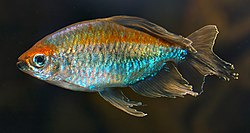| Alestidae Temporal range: | |
|---|---|
 | |
| Brycinus longipinnis | |
| Scientific classification | |
| Kingdom: | Animalia |
| Phylum: | Chordata |
| Class: | Actinopterygii |
| Order: | Characiformes |
| Suborder: | Characoidei |
| Family: | Alestidae Cockerell 1910 [1] |
| Genera | |
See text | |
African tetras (family Alestidae, formerly spelled Alestiidae) are a group of characiform fish found exclusively in Africa. [2] This family contains about 18 genera and 119 species. Among the best known members are the Congo tetra, and African tigerfish.
Although presently found only in Africa, fossil evidence suggests that during the Paleogene, they ranged as far north as southern Europe and as far east as the Arabian subcontinent. [3] Fossil remains date back to potentially the Late Paleocene with Hydrocynus remains known from Algeria. [4] Alestid-like teeth are also known from the Late Cretaceous (Maastrichtian) of France, and phylogenetic evidence also suggests that they diverged around this time. [5] [6]

